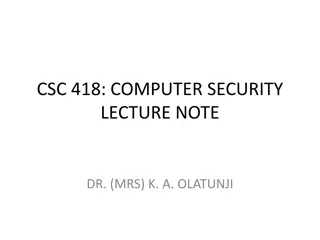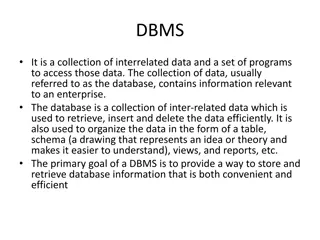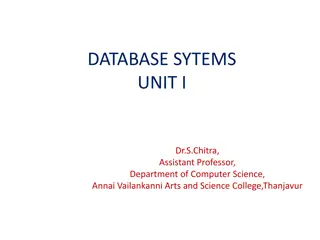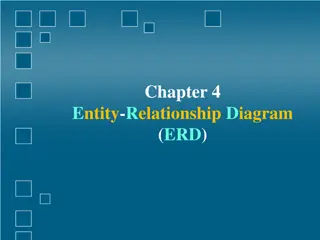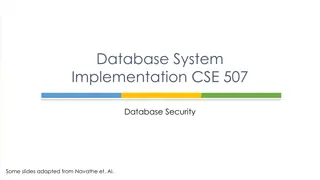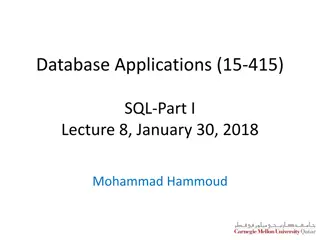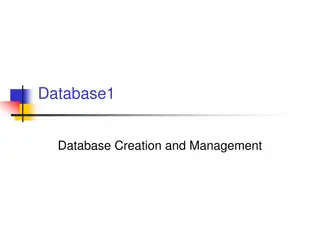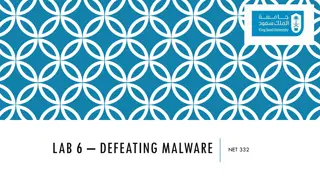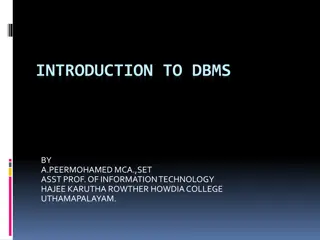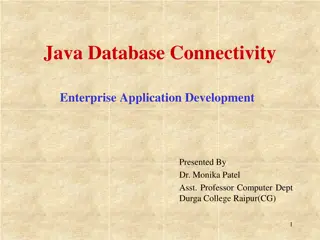Introduction to Database Security and Countermeasures
Database security is essential to protect data integrity, availability, and confidentiality. Countermeasures such as access control, inference control, flow control, and encryption can safeguard databases against threats. Access control restricts user access, inference control manages statistical data access, and flow control prevents unauthorized information flow. Database security mechanisms include discretionary and mandatory security measures to prevent unauthorized access.
Download Presentation

Please find below an Image/Link to download the presentation.
The content on the website is provided AS IS for your information and personal use only. It may not be sold, licensed, or shared on other websites without obtaining consent from the author.If you encounter any issues during the download, it is possible that the publisher has removed the file from their server.
You are allowed to download the files provided on this website for personal or commercial use, subject to the condition that they are used lawfully. All files are the property of their respective owners.
The content on the website is provided AS IS for your information and personal use only. It may not be sold, licensed, or shared on other websites without obtaining consent from the author.
E N D
Presentation Transcript
Database System Implementation CSE 507 Database Security Some slides adapted from Navathe et. Al.
Introduction to Database Security Threats to databases Loss of integrity Loss of availability Loss of confidentiality To protect databases against these types of threats four kinds of countermeasures can be implemented: Access control Inference control Flow control Encryption
Introduction to Database Security Threats to databases Loss of integrity Loss of availability Loss of confidentiality To protect databases against these types of threats four kinds of countermeasures can be implemented: Access control Inference control Flow control Encryption --- Details out of the scope of this course
Intro to Database Security Access Control The security mechanism of a DBMS must include provisions for restricting access to the database as a whole. This function is called access control and is handled by creating user accounts and passwords to control login process by the DBMS.
Intro to Database Security Inference Control Another security problem associated with databases is that of controlling the access to a statistical database, These database are used to provide statistical information or summaries of values based on various criteria. The countermeasures to statistical database security problem is called inference control measures.
Intro to Database Security Flow Control Another security is that of flow control, which prevents information from flowing in such a way that it reaches unauthorized users. Channels that are pathways for information to flow implicitly in ways that violate the security policy of an organization are called covert channels.
Intro to Database Security Access Control A DBMS typically includes a database security and authorization subsystem that is responsible for ensuring the security portions of a database against unauthorized access. Two types of database security mechanisms: Discretionary security mechanisms Mandatory security mechanisms
Database Security and DBA The DBA has a DBA account in the DBMS Sometimes these are called a system or superuser account These accounts provide powerful capabilities such as: 1. Account creation 2. Privilege granting 3. Privilege revocation 4. Security level assignment Action 1 is access control, whereas 2 and 3 are discretionary and 4 is used to control mandatory authorization
Discretionary Access Control Based on Grant and Revoke The typical method of enforcing discretionary access control in a database system is based on the granting and revokingprivileges.
Types of Discretionary Access Control The account level: At this level, the DBA specifies the particular privileges that each account holds independently of the relations in the database. The relation level (or table level): At this level, the DBA can control the privilege to access each individual relation or view in the database.
Types of Discretionary Access Control The privileges at the account level apply to the capabilities provided to the account itself and can include the CREATE SCHEMA or CREATE TABLE privilege, to create a schema or base relation; the CREATE VIEW privilege; the ALTER privilege, to apply schema changes such adding or removing attributes from relations; the DROP privilege, to delete relations or views; the MODIFY privilege, to insert, delete, or update tuples; and the SELECT privilege, to retrieve information from the database by using a SELECT query.
Types of Discretionary Access Control Relation level This includes base relations and virtual (view) relations. Each relation R in a database is assigned and owner account, This is typically the account that was used when the relation was created in the first place. The owner of a relation is given all privileges on that relation. The owner account holder can pass privileges on any of the owned relation to other users by granting privileges to their accounts.
Specifying Privileges using Views If the owner A of a relation R wants another account B to be able to retrieve only some fields of R, then A can create a view V of R that includes only those attributes and then grant SELECT on V to B. The same applies to limiting B to retrieving only certain tuples of R; a view V can be created by defining the view by means of a query that selects only those tuples from R that A wants to allow B to access.
Revoking Privileges In some cases it is desirable to grant a privilege to a user temporarily. For example, The owner of a relation may want to grant the SELECT privilege to a user for a specific task and then revoke that privilege once the task is completed. Hence, a mechanism for revoking privileges is needed. In SQL, a REVOKE command is included for the purpose of canceling privileges.
Propagation of Privileges using the GRANT option If the owner A grants a privilege on R to another account B, privilege can be given to B with or without the GRANT OPTION. If the GRANT OPTION is given, this means that B can also grant that privilege on R to other accounts. This way, privileges on R can propagate to other accounts without the knowledge of the owner of R. If the owner account A now revokes the privilege granted to B, all the privileges that B propagated based on that privilege should automatically be revoked by the system.
Example on GRANT option 1. DBA grants insert, update, delete, and select privileges on Department table to Jack with GRANT option. 2. DBA grants select and insert privilege on Dept table to Ria. 3. Jack grants insert privilege on Dept table to Ria with GRANT option. 4. Ria grants insert privilege on Dept table to Allen with GRANT option. 5. Jack grants insert privileges on Dept table to Allen with GRANT option.
Mandatory Access Control Discretionary access control techniques been the main mechanism in DBMS In many applications, an additional security policy is needed to classify data and users based on security classes. Mandatory access control helps here, This is typically be combined with the discretionary access control mechanisms.
Mandatory Access Control Typical security classes Top secret (TS), Secret (S), Confidential (C), Unclassified (U), Here TS is the highest level and U the lowest: TS > S > C > U
Mandatory Access Control Bell- LaPadula Model Subjects E.g., user, account, program Objects E.g., Relation, tuple, column, view, operation. Subjects and Objects classified into, T, S, C, or U: Clearance (classification) of a subject S denoted as class(S) and to the classification of an object O as class(O).
Mandatory Access Control Bell- LaPadula Model Two restrictions are enforced on data access based on the subject/object classifications: Simple security property: A subject S is not allowed read access to an object O unless class(S) class(O). Star property: A subject S is not allowed to write an object O unless class(S) class(O).
Mandatory Access Control Multilevel Security To incorporate multilevel security, we consider attribute values and tuples as data objects. Each attribute A is associated with a range of classification attribute C = [L H] in the schema, And each attribute value in a tuple instance is associated with a security classifications inside its range [L H] In addition, in some models, a tuple classification attribute TC is added to the relation attributes to provide a classification for each tuple as a whole.
Mandatory Access Control Multilevel Security Hence, a multilevel relation schema R with n attributes would be represented as R(A1,C1,A2,C2, , An,Cn,TC) where each Ci represents the classification attribute associated with attribute Ai.
Mandatory Access Control Multilevel Security Apparent key of a multilevel relation is the set of attributes that would have formed the primary key in a regular (single-level) relation.
Mandatory Access Control Multilevel Security A multilevel relation will appear to contain different data to subjects (users) with different clearance levels. It is possible to store a single tuple at a higher classification level and produce the corresponding tuples at a lower-level classification through a process known as filtering.
Mandatory Access Control Multilevel Security In other cases, it is necessary to store two or more tuples at different classification levels with the same value for the apparent key. Polyinstantiation: Here several tuples can have the same apparent key value but have different attribute values for users at different classification levels.
Mandatory Access Control Multilevel Security Entity integrity rule for multilevel relations: Member attributes of the apparent key must not be null And must have the same security classification within each individual tuple. To make sure that we either see the entire key or no key at all In addition, all other attribute values in the tuple must have a security classification greater than or equal to that of the apparent key. So that we don t associate non-null values to null values of key.

 undefined
undefined


